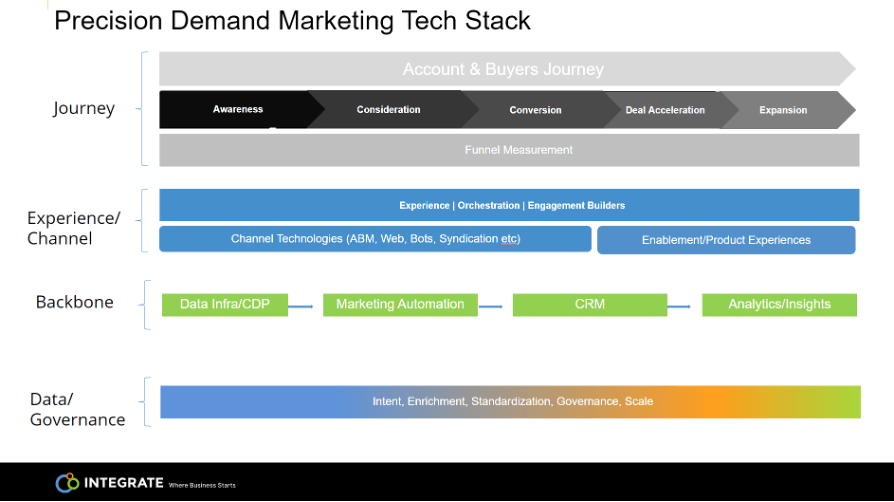Cross-Channel Insights: The Winning Ticket to Defending Your Spend
I’ve been in Marketing Operations since its inception over two decades ago and have had a front row ticket to B2B marketing’s evolution. I’ve seen the rules change, the players advance, and the technology grow. Gone are the days where we believed that a single touch from a single campaign resulted in pipeline or revenue. Gone are the days where email reigned supreme. Gone are the days where we only focused on and measured leads.
Today, we’re living in an increasingly complex and omnichannel world. We’re reading news sites and blogs, watching online videos, checking our social media feeds, scanning our emails, attending virtual events and webinars, and now, re-engaging with in-person events. And that means that our buyers are too.
But the one rule that has remained constant? We still need to defend the marketing spend. That means, every program needs to be scrutinized. Every lead must be valid. And every dollar must be spent well.
With this in mind, how do we reframe our processes to accommodate today’s buyer-driven, omnichannel world? I think of it in terms of 3 keys steps: activating, governing, and measuring our campaigns across demand channels.
Step 1: Activating Across Channels
We must recognize the importance of having engagement across the entire B2B buyer’s journey, including social, content syndication, digital marketing, capturing leads at events and tradeshows, and other demand channels.
We recently had an account where 24 people were involved and 170 marketing touches were completed over 245 days, which resulted in 8 opportunities and an LTV of over $250K. For complex sales cycles, it is imperative to engage your buyers in the channels and at the time of their choosing, and to make it as cost effective as possible.
One of the best ways to meet your buyers where they are is to make sure that you have relevant content in the channels where those buyers spend their time researching and learning about your products. To do this, you need to make sure that you have the entire buying committee built out in your CRM, all your systems referring to this data, and a clear understanding of where the account and the person is in their journey.
At Integrate, we do this using account and contact statuses. Our account status ranges from cold, to researching, to aware, engaged and marketing qualified account (MQA). Each status leverages different data points and is updated nightly. The status of “researching” looks at two different intent data sources, “aware” considers all digital engagements from the account, “engaged” means we have responses, but the responses are either not an MQL or outside of our buying committee. And finally, “MQA” means that we have two or more MQLs within the buying committee.
Through understanding where the account is in its journey, you can execute different cross channel strategies. For example, when we see accounts that are actively researching, we implement a digital ad strategy with the goal of digital engagement. Once we have digital engagement, this triggers a larger surround effort that now adds in syndication, email, social, such as targeted LinkedIn strategies and SDR outreach with the goal of getting a response.
Step 2: Governing Cross-Channel Data
Data is at the core of what we do in Marketing Ops and it is what we use to begin to execute cross channel experiences. It is crucial to ensure that all your marketing efforts are fully compliant and governed. I am continually monitoring the health of our database, identifying where and how bad data is entering my system and then putting processes into place to minimize or prevent bad data from entering my system. Bad data costs you money, both at the point of entry (e.g. an incomplete or incorrect lead) and down funnel as you implement additional campaigns. No one can afford to fill their marketing database with bad data and governing it is a crucial, everyday step for Marketing Operations.
Step 3: Measuring Cross-Channel
To efficiently measure across channels, you need to understand all the touch points across the lifetime of an opportunity. You need to understand not only sourcing but influencing of the opportunities and enable your teams to understand the complete picture of all the touches across the journey. This complete picture enables the sales teams to have more and better conversations with those highly engaged accounts and it enables marketing to understand what programs are both sourcing and influencing opportunities.
The Cross-Channel Technology
In Marketing Ops, our thoughts always go straight to the technology. What cross-channel and omnichannel technologies are out there?
When I think about my technology stack, I approach it from the buyer’s experience. I think about it in 4 layers. A journey layer, where I work with my rev marketing and product marketing teams to understand the personas and content across the journeys and how we are going to tag and measure these journeys.
I then move into the technology layer where the experiences are being delivered. This is done through multiple different pieces of technology. From there, I move into my backbone, where all the data enters, gets cleaned, standardized, routed, alerted, and prioritized. This is the layer that controls the next step in one’s journey. Lastly, the data feed layer, this is where we bring in third party data to augment the data flowing through the backbone, it is here is where I handle governance, more standardization, and enrichment. All of this allows me to scale into different regions while maintaining a solid data handling process.

Marketing Ops Today
Throughout my career, Integrate has been a critical foundational piece of my technology infrastructure. I have always used Integrate to manage my syndication leads, ensuring that I am getting the right people from the right accounts into my system, all while checking the compliance box.
But today I’m even more excited to have the ability to identify accounts that are in market and put into place a cross-channel strategy all within one platform. With Integrate, I can identify those accounts that are in market, surround them with digital ads, and drive response through syndication programs to further qualify those leads. I can invite those prospects to a webinar or in-person event and reach them through social media as well.
A lot has changed in the twenty or so years I’ve been in marketing operations and we finally have the winning ticket: the right kind of technologies that enable us to take a holistic, cross-channel view, and truly defend our spend.
To learn more about cross-channel execution, check out our guides:









